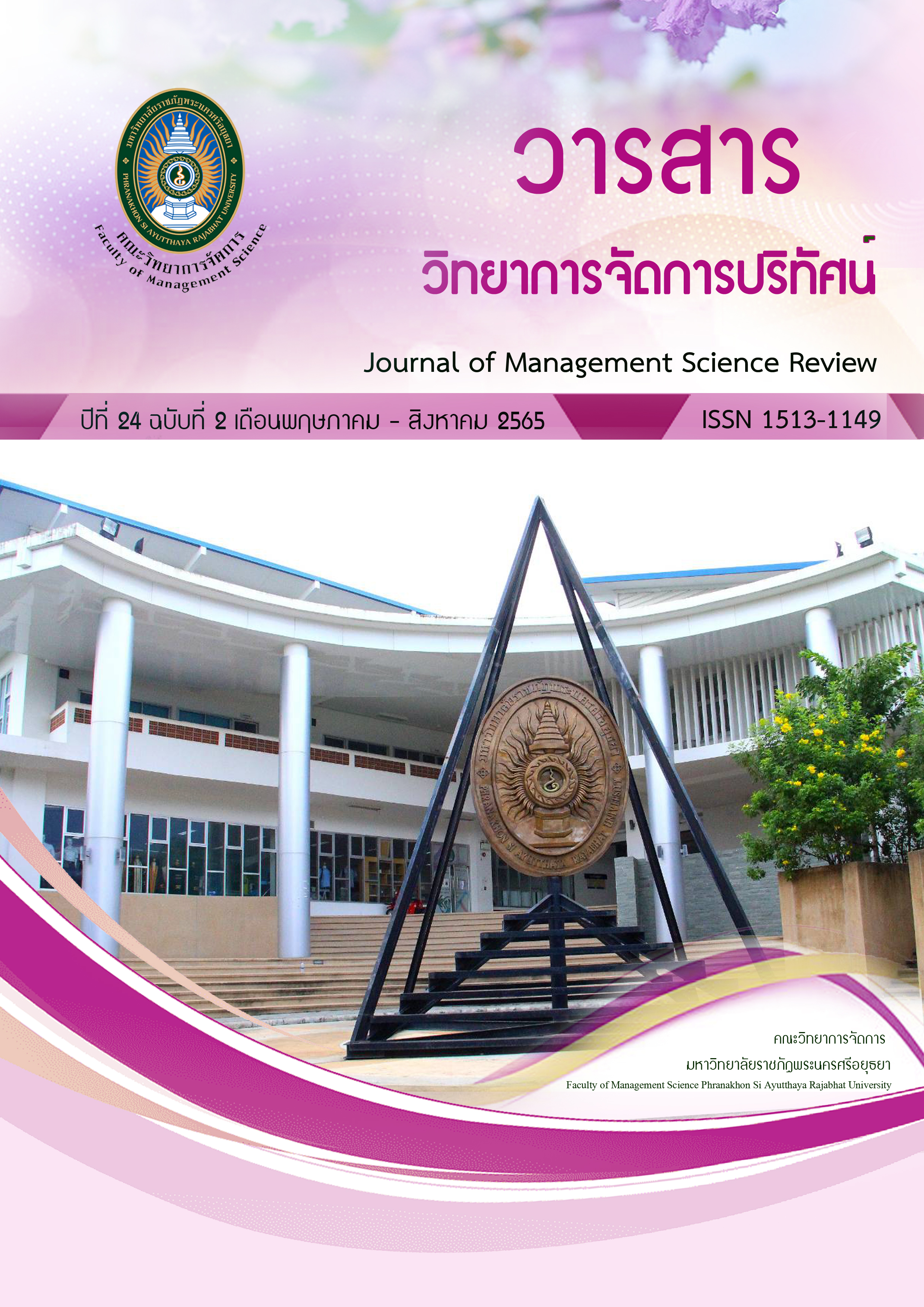Leadership with Medical Records Management in the Digital Age
Keywords:
Leadership, Medical Record, Digital AgeAbstract
This academic article analyzed leadership in the management of medical records in the digital age. Leadership theory consisting of trait theory, behavioral leadership theory, situational leadership theory, and transformational leadership theory were used to analyze together with the changes in the digital age in the context of medical records management of health care facilities in Thailand. According to the analysis, there were suggestions about leadership and medical records management in the digital age. Leaders in medical records agencies in the digital age must have the knowledge and high competence maturity in order to keep up with changes, morals, and ethics, and be able to apply the theory of leadership to suit the situation, flexible and changeable according to the appropriate environment under the leadership standpoint. If a leader had the qualities of a good leader, followers would act willingly resulting in efficient work. Leadership was therefore important and necessary to management in order to comply with policies and lead the organization to success in this rapidly changing era like the digital age.
References
กิตติ์กาญจน์ ปฏิพันธิ์. (2560). โมเดลสมการโครงสร้างภาวะผู้นําเชิงสร้างสรรค์ของผู้บริหารสถานศึกษาอาชีวศึกษา. วิทยานิพนธ์ปรัชญาดุษฏีบัณฑิต สาขาวิชาการบริหารการศึกษา, มหาวิทยาลัยขอนแก่น.
จันจิรา ดีเลิศ และสุวรรณา สิทธนาวิวัฒน์. (2564). ระบบบริหารทรัพยากรองค์กร: เครื่องมือสู่ความสำเร็จอุตสาหกรรมการผลิตในประเทศไทย. วารสารวิทยาการจัดการปริทัศน์, 23(2), 247-256.
นพมาส เครือสุวรรณ และประเสริฐ อินทร์รักษ์. (2561). การบริหารการพัฒนางานเวชระเบียนในประเทศไทย. วารสารบัณฑิตวิทยาลัย มหาวิทยาลัยดุสิต, 14(2), 171-189.
พิชญาภา ยืนยาว. (2562). ภาวะผู้นำทางการบริหารการศึกษาและสถานศึกษา (พิมพ์ครั้งที่ 3). นครปฐม: มหาวิทยาลัยราชภัฏนครปฐม.
พลกฤต รักจุล และคณะ. (2563). ภาวะผู้นำการเปลี่ยนแปลง ความผูกพัน และความตั้งใจที่จะคงอยู่ของพนักงาน: ทบทวนวรรณกรรม. วารสารสังคมศาสตร์และมานุษยวิทยาเชิงพุทธ, 5(12), 15-29.
รุ่งรัตน์ พลชัย. (2563). ภาวะผู้นำกับการบริหารในยุคดิจิทัล. วารสารมนุษยศาสตร์และสังคมศาสตร์ มมร วิทยาเขตอีสาน, 1(3), 53-62.
ศูนย์เทคโนโลยีและนวัตกรรมดิจิทัลภาครัฐ.(มปป.) Digital Transformation เปลี่ยนแปลงแนวความคิดอย่างไร?. ค้นเมื่อ 8 พฤษภาคม 2565, จาก https:// dgti.dga.or.th/digital-transformation-2/
ศิริพงษ์ กลั่นไพฑูรย์. (2564). รูปแบบการพัฒนาภาวะผู้นำทางวิชาการในยุคดิจิทัลของผู้บริหารสถานศึกษาขั้นพื้นฐาน. วิทยานิพนธ์การศึกษาดุษฎีบัณฑิต สาขาวิชาการบริหารการศึกษา, มหาวิทยาลัยนเรศวร.
สุภัทรศักดิ์ คำสามารถ และคณะ. (2563). แนวทางการบริหารการศึกษาในยุคดิจิทัลดิสรัปชั่น. Journal of Modern Learning Development, 5(3), 245-259.
สุรีรัตน์ โตขียว. (2560). รูปแบบภาวะผู้นำของผู้บริหารสถานศึกษาขั้นพื้นฐานในศตวรรษที่ 21. วิทยานิพนธ์ครุศาสตรดุษฎีบัณฑิต, สาขาวิชาการบริหารการศึกษา, มหาวิทยาลัยราชภัฏนครสวรรค์.
แสงเทียน อยู่เถาว์. (2560). การบริหารงานเวชระเบียน. กรุงเทพฯ: แห่งจุฬาลงกรณ์มหาวิทยาลัย.
สำนักงานคณะกรรมการข้าราชการพลเรือน, มาตรฐานกำหนดตำแหน่ง. ค้นเมื่อ 9 พฤษภาคม 2565, จาก www.ocsc.go.th/job/standard-position.
สำนักงานพัฒนาธุรกรรมทางอิเล็กทรอนิกส์. (2563). “E-Medical Record” ข้อมูลประวัติการรักษาผู้ป่วยของสถานพยาบาลหรือสถานบริการสาธารณสุขที่จัดเก็บในรูปของข้อมูลอิเล็กทรอนิกส์. ค้นเมื่อ 13 พฤษภาคม 2565, จาก https://www.etda.or.th/th/OurService/Standard(1)/Certifications/Example-1/Electronic-list.aspx
สำนักนโยบายและยุทธศาสตร์ สำนักงานปลัดกระทรวงสาธารณสุข. (2559). แผนยุทธศาสตร์ชาติ ระยะ 20 ปี (ด้านสาธารณสุข). ค้นเมื่อ 13 พฤษภาคม 2565, จาก https://waa.inter.nstda.or.th/stks/pub/2017/20171117-MinistryofPublicHealth.pdf
Fiedler, E. F. (1967). A Theory of Leadership Effectiveness. New York: McGraw-Hill.
Hersey, P. & Blanchard, K. H. (1969). Life cycle theory of leadership. Training and Development Journal, 2(1), 6-34.
Hess, T. et al. (2016). Options for Formulating a Digital Transformation Strategy. MIS Quarterly Executive (15:2), 123-139.
Hoy, K. W. & Miskel, C. G. (1991). Education Administration: Theory. Research and Practice. New York: McGraw-Hill.
Huffman, Edna K. (1990). Medical Record management (9th ed). Berwyn: Physicians Record Company.
Jantzi, D. & Leithwood, K. (1996). Toward an explanation of variation in teachers' perceptions of transformational school leadership. Educational administration quarterly, 32(4), 512-538.
Likert, R. (1967). The human organization: its management and values. New York: McGraw-Hill.
Lussier, R. N. & Achua, C. F. (2007). Leadership: Theory, Application, Skill Development (3rd ed). Ohio: Thomson Learning.
McCall, M. W. (1986). Leadership and Performance Beyond Expectations, by Bernard M. Bass (Book Review). Human Resource Management, 25(3), 481-484.
Mitchell, T. R. & Larson, J. R. (1987). People in Organizations: An Introduction to Organization Behavior (3rd ed). New York: McGraw-Hill.
Reis, J. (2018). Digital transformation: A literature review and guidelines for future research. In World CIST'18 2018, AISC 745, (pp.411–421). Chicago.
Stanfield, P. S., Cross, N. & Hui, H. (2011). Introduction to the Health professions (6th ed). California: Jones & Bartlett Publishers.
Stogdill, R. M. (1974). Handbook of leadership: A survey of theory and research. New York: Free Press.
Subbrain. (2019). Important People in Digital Era. Retrieved 2022, 6 May, from https://www.subbrain.com/marketing/important-people-in-digital-era/
Wang, Y. et al. (2018). Big data analytics: Understanding its capabilities and potential benefits for healthcare organizations. Technological forecasting & Social Change, 126. 3-13.
World Health Organization. (2006). Medical Records Manual: A guide for Developing Countries. Geneva, Switzerland: World Health Organization.
Yukl, G. A. & Becker, W. S. (2006). Effective empowerment in organizations. Organization Management Journal, 3(3), 210-231.




